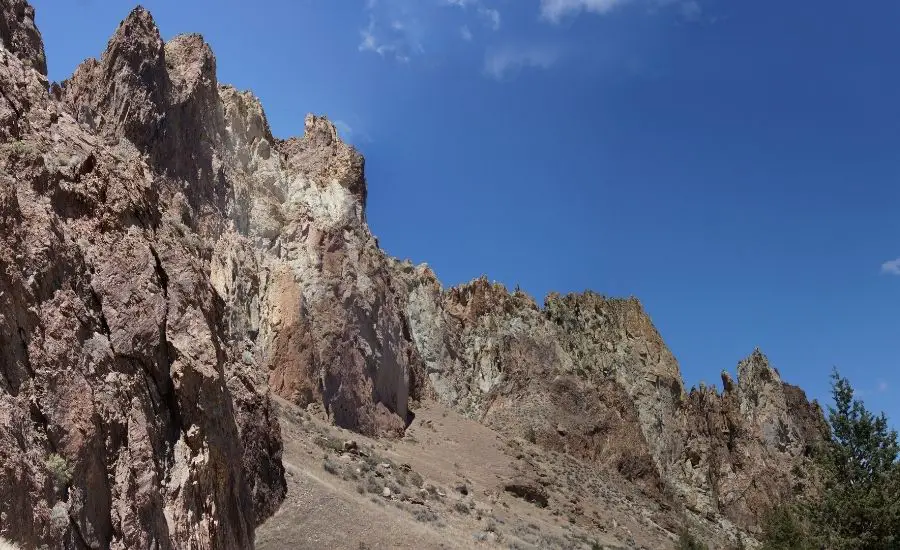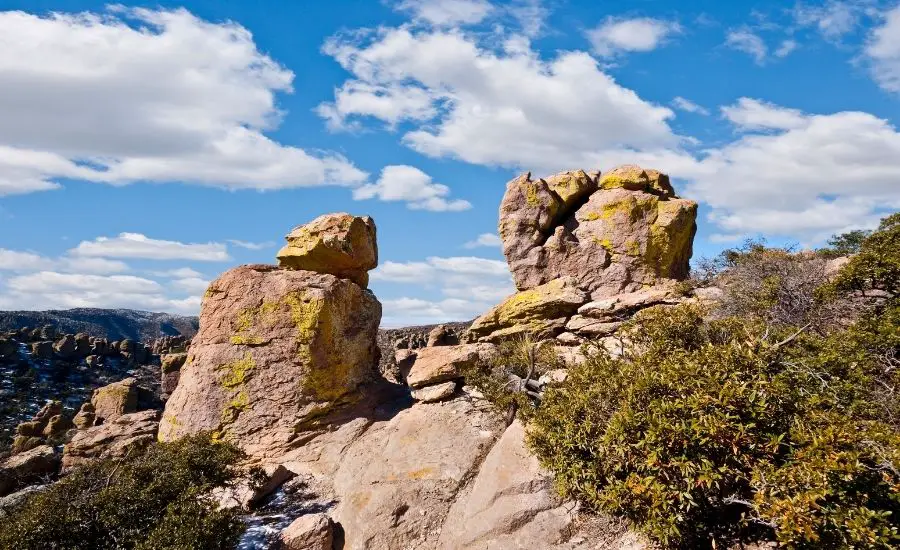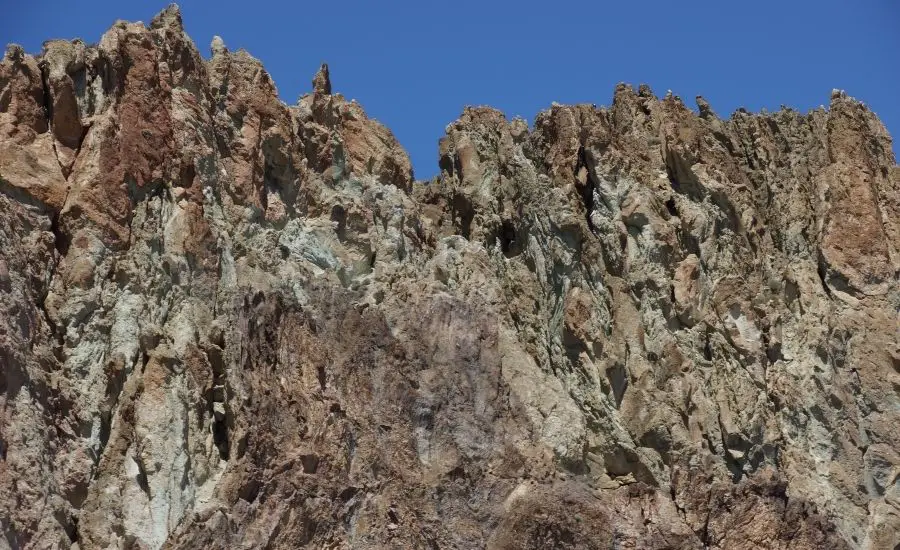Although rhyolite is not as popular in the rock climbing community as granite or sandstone, there are many rhyolite climbing routes out there in the world. As a geologist and climber myself, I was intrigued to see just how good rhyolite is for rock climbing.
On average, rhyolite is one of the best rock types for rock climbing. Rhyolite’s texture provides climbers with excellent grip without being too abrasive on the hands. Rhyolite formations typically provide a wide variety of features and holds for climbers to use.
There are a few things you need to watch out for when climbing on rhyolite. This article dives into the intricacies of rhyolite and how its properties affect its ability to be climbed on. At the end, you can see a list of some of the top places in the world to climb on rhyolite!
If you are a big geology nerd like myself and want to learn more how all rock types affect climbing, I recommend checking out this book on Amazon!
How Good is Rhyolite For Rock Climbing

If you are a rock-nerd like myself, I recommend checking out this information provided on GeologyScience.com to brief up on your rhyolite knowledge. If you really aren’t all that interested in the geology behind rhyolite, then that’s all good too. I will try to keep things simple and only talk about how rhyolite’s properties relate to its climbing experience.
Rhyolite is an extrusive igneous rock of felsic composition. In layman’s terms, rhyolite is typically a light grey to pink rock formed by erupted volcanic magma that cooled quickly. As such, this causes rhyolite to be fine-grained and hard.
Due to it’s magmatic origins, rhyolite is typically very solid and sturdy to climb on. An article on GeoForwad.com states that these types of rocks are equally good for bouldering and sport climbing.
Various climbers have touted rhyolite as being fantastic for climbing. Even The Climbing Handbook (a comprehensive guide to rock climbing) has mentioned rhyolite’s fantastic climbing properties. If you are interested in learning more about The Climbing Handbook, I suggest checking it out on Amazon linked here.
“Rhyolite provides some of the very best and most highly featured rocks for climbing…”
The Climbing Handbook via Jessica Ball, American Geophysics Union (AGU) Blog
Rhyolite’s fine grained texture makes great climbing holds as it provides climbers with grip but isn’t too abrasive. This texture of rhyolite makes it very friendly to climber’s hands.
It should be noted that some rhyolite formations can be a bit slippery if the grain is too fine (if the rock cooled too quickly). That being said, you will be hard pressed to find these slick outcrops of rhyolite. If you are wondering if there is a best rock for climbing, check out my article here.
Typical Rhyolite Climbing Features
Rhyolite’s formational environment causes it to have very unique rock formations. These unique formations provide climbers with an opportunity to try out many different climbing styles.
Columnar Rhyolite

While these are not common to see, columnar rhyolite formations do exist. These columnar formations, although rare, are fantastic for climbing. They provide climbers with pristine crack climbing and ample opportunities to practice their bridging.
If you are intrigued about climbing columnar rock formations, I highly recommend you check out my Climbing on Basalt article. Columnar basalt is a lot more common than columnar rhyolite. Due to this, there are many top-notch places in the world where you can experience columnar rock climbing.
Other Rhyolite Formations

As described in the section(s) above, rhyolite is formed by volcanic eruptions. These eruptions typically take place within the continents and are explosive in nature. This causes rhyolite to be deposited in a large variety of formations.
The shape and nature of these formations will dictate how good they are for climbing and which type of climbing. For instance, the columnar rhyolite formations are fantastic for sport climbing (specifically crack climbing). On the other hand, the rhyolite formation pictured above is much better suited to bouldering.
In addition to this, the chaotic formation environment makes the vast majority of rhyolite formations highly featured. These various features provide climbers with many different hold types to pick from.
Rhyolite Climbing and The Effects of Weather Conditions and Weathering
Weather conditions such as rain and snow have both short and long term effect on rocks.
How Rhyolite Handles Weather Conditions
Rhyolite is fine-grained and therefore will not typically absorb a large amount of water. In addition to this, rhyolite is an igneous rock which makes it relatively strong and compact.
On average, you are able to climb on wet rhyolite after it rains as long as the rhyolite formation is in good condition. Rhyolite will become dry relatively quickly due to its crystalline structure and fine-grained texture. It even can be completely dry within an hour of hot, dry, and sunny conditions.

Rhyolite and The Effects of Long Term Weathering
Rhyolite, similar to granite, is one of the most weather-resistant rocks on the planet. This is due to rhyolite’s felsic composition and crystalline structure. Basically, felsic composition just means it has a very high silica content. Rocks containing a high silica content are able to stand up exceptionally well to chemical weathering.
That being said, rhyolite is not completely impervious to weathering. Old rhyolite that has been on this planet for a long period of time will start to degrade and lose its solid structure. This can cause it to break when climbed on.
As you may have guessed, climbing on weathered rhyolite is extremely dangerous. DO NOT DO THIS. Only climb on rhyolite that you know is fresh and solid. It is not worth taking the risk. Sandstone and limestone are rocks that are especially subject to weathering and those need treated with extreme caution.
Best Places for Rhyolite Climbing

Rhyolite outcrops are relatively common throughout the world but are not “everywhere”. That being said, there are more than a few locations that provide climbers with fantastic rhyolite climbing opportunities. Listed below are 11 of the best places on earth to climb on rhyolite.
11 of the Best Places in the World to Climb on Rhyolite
- Glen Coe, Scotland
- The Borrowdale Valley, United Kingdom
- Ogwen Valley, Wales
- Luna Park, New Mexico
- Mammoth Lakes, California
- Box Canyon, New Mexico
- Ben Nevis, Scotland
- Palisade Head, Minnesota
- Lake District, United Kingdom
- Ophir Wall, Colorado
- La Concepción (aka La Cascada), Mexico
All of these places are fantastic for rhyolite climbs!
Disclaimer: Rock climbing is a dangerous sport which has the potential to result in serious injury or death. This article was written solely to provide information and insight pertaining to the relationship between geology and rock climbing. The information in this article is not to be relied on for guidance pertaining to the health and safety of any rock climbing activities.
